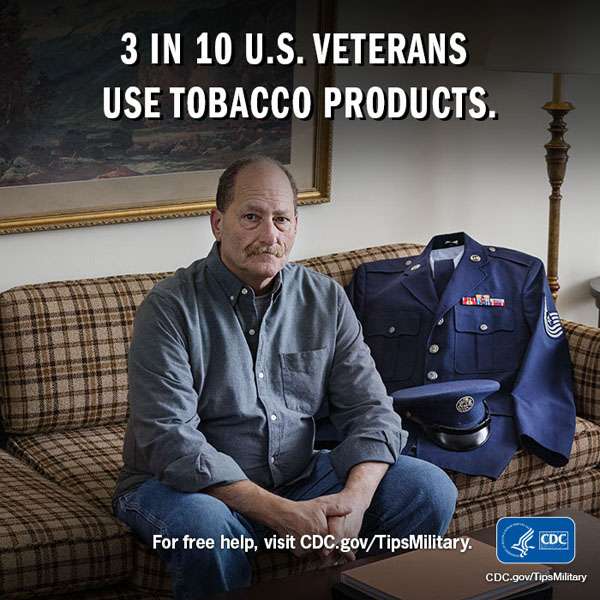About three in ten US veterans use tobacco products
Veterans use tobacco at much higher rates than most non-veterans
Press Release
For Immediate Release
Thursday, January 11, 2018
Contact: Media Relations
(404) 639-3286
About 3 in 10 U.S. military veterans used some form of tobacco product during 2010–2015, according to new data published by the Centers for Disease Control and Prevention in today’s Morbidity and Mortality Weekly Report (MMWR). Tobacco product use was higher among veterans than among non-veterans for males and females across all age groups, except males ages 50 years and older.
CDC used data from the National Survey on Drug Use and Health (NSDUH) to assess the different tobacco products currently used (in the past 30 days) by U.S. veterans and non-veterans. Current use among veterans was highest for cigarettes (21.6 percent), followed by cigars (6.2 percent), smokeless tobacco (5.2 percent), roll-your-own tobacco (3.0 percent), and pipes (1.5 percent).
“These findings highlight the importance of further protecting the health of our military veterans,” said Corinne Graffunder, Dr.P.H., director of CDC’s Office on Smoking and Health. “We must redouble our efforts to help veterans quit and reduce the preventable suffering and premature death caused by tobacco use.”
Key findings
- Among both veterans and non-veterans, the prevalence of any tobacco product use was significantly higher among males than among females in each age group, except veterans ages 50 and older.
- Among veterans, current use of any of the tobacco products was higher among those:
- with no health insurance (60.1 percent)
- living in poverty (53.7 percent)
- ages 18–25 years (56.8 percent)
- reporting serious psychological distress (48.2 percent)
- with annual family income <$20,000 (44.3 percent), and
- with less than a high school diploma (37.9 percent).
- The high prevalence of tobacco use among military and veteran personnel has a significant financial impact. Barnette and colleagues found that during 2010, Veterans Health Administration (VHA) spent an estimated $2.7 billion on smoking-related ambulatory care, prescription drugs, hospitalization, and home health care.
“VA has more tobacco use treatment options available than ever and we are committed to continuing to lower the rate of smoking among Veterans enrolled in VA and to providing individualized support to help Veterans become tobacco-free,” said Kim Hamlett-Berry, Ph.D., Program Director of VA Tobacco & Health Policy. “Historically, rates of smoking among all Veterans—including those enrolled in VA—have been high. However, we have seen progress with declines in cigarette use among enrolled Veterans. The 2015 VA Survey of Enrollees reported that 16.8 percent of Veterans enrolled for health care in VA identified as a current smoker.”
What more can be done?
Because more than a third of active duty military who smoke started after enlisting, evidence-based tobacco control interventions that are effective for both current and former military members are important to reduce tobacco use among veterans.
Strategies could include promoting cessation to current military personnel and veterans, implementing tobacco-free policies at military installations and Veterans Affairs (VA) medical centers and clinics, increasing the age requirement to buy tobacco on military bases to 21 years, and eliminating tobacco product discounts through military retailers.
Veterans who receive their health care through VA can access treatment, including medications and counseling from their provider, as well as free quit help at 1-855-QUIT-VET (1-855-784-8838) and SmokefreeVET, a supportive text messaging service. Veterans may also access online tobacco cessation resources at https://www.publichealth.va.gov/smoking/ and https://smokefree.gov/veterans.
Non-veterans and veterans not enrolled in VA health care can call 1-800-QUIT-NOW (1-800-784-8669) to speak with a quitline counselor or visit https://www.smokefree.gov for comprehensive mobile health resources, evidence-based information, and support. Active duty and retired service members and their families can access quit services through their TRICARE coverage and Department of Defense programs.
Additionally, CDC’s Tips From Former Smokers® campaign (https://www.cdc.gov/TipsMilitary) features real stories to motivate smokers to quit, including military service members and veterans who live with smoking-related diseases and disabilities.

